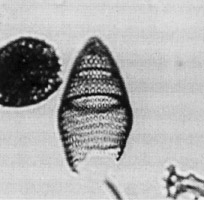 Phormostichoartus
doliolum (Riedel and Sanfilippo)
Phormostichoartus
doliolum (Riedel and Sanfilippo) Phormostichoartus
doliolum (Riedel and Sanfilippo)
Phormostichoartus
doliolum (Riedel and Sanfilippo)Artostrobium doliolum Riedel and Sanfilippo, 1971, p.1599, pl.1H, figs.1-3, pl.8, figs.14-15
Phormostichoartus doliolum (Riedel and Sanfilippo), Nigrini, 1977, p.252, pl.1, fig.14.
Spindle-shaped, four-segmented artostrobiid in which the intersegmental strictures are not strongly pronounced externally. Cephalis very small, spherical bearing a lateral tube that lies along the thoracic wall and is thus directed obliquely downward. Thorax and third segment truncate-conical; fourth segment the widest, tapering distally, in some specimens with a poreless peristome. All post-cephalic segments with pores in closely-spaced transverse rows (Riedel and Sanfilippo, 1971).
Total length 110-155 µm; maximum breadth 70-95 µm. Riedel and Sanfilippo (1971) recorded total lengths as short as 95 µm (Nigrini, 1977).
Four-segmented, broadly spindle-shaped, without pronounced strictures externally. No horn (Riedel and Sanfilippo, 1978a, as Artostrobium doliolum).
This species was redefined by Westberg and Riedel (1978) as "including only those specimens in which the width of the third stricture is 65 µm or greater (which corresponds, in most specimens, to a maximum shell breadth of 75 µm). The width of the third stricture, instead of the maximum breadth, is now proposed as the distinguishing character because of the large number of specimens in which the fourth segment is broken."
This low-latitude species is very rare beginning in the Didymocyrtis antepenultima Zone, becoming increasingly common in younger sediments to a peak abundance in the Stichocorys peregrina Zone, then tapering off in the Spongaster pentas Zone (Nigrini, 1977).
Its morphotypic last appearance is a reliable and easily recognizable synchronous event.
This species apparently developed from Phormostichoartus marylandicus (Nigrini, 1977, p.253, pl.2, figs.1-4), a form with less developed third segment, more widely separated rows of pores and somewhat more pronounced intersegmental strictures.
In the Indian Ocean, Johnson et al. (1989) used the upper limit of P. doliolum to subdivide the Spongaster pentas Zone.